The snow leopard is a big cat, too.
Like the jaguar – except it is built to deal with snow.
So also the F-Pace, which is the snow leopard of Jaguars.
It has more than twice the ground clearance (8.3 inches) of an XJ sedan or an F-Type coupe and comes standard with claw-the-road (paved or not) all-wheel-drive.
This Jag is also available with a diesel engine – which no rival offers.
Not Audi – and not Porsche.
Not anymore.
Because of their relation to VW – and you know the rest of that story.
BMW and Mercedes, meanwhile, have preemptively bailed out of the compression-ignition market, having concluded it’s just too much hassle – and too expensive – to deal with the EPA’s Inspector Javert-like obsessions over fractional differences in diesel exhaust emissions. Getting to that next “bin” or “tier” isn’t worth it, apparently.
Which leaves the diesel-powered F-Pace as sui generis, one of a kind.
The F-Pace is a five-passenger luxury-sport crossover SUV.
It’s a compact bordering on mid-size, about the same size as a Porsche Macan and similar in concept, but the Jag costs thousands less to start. And unlike the Porsche, the Jag’s available with a long-legged/high-miles and big torque diesel engine.
Base price is $42,065 for the gas turbo-powered 25t trim vs. $47,800 to start for the Porsche.
When equipped with its optional turbodiesel engine ($46,275 to start) the Jag is capable of averaging mid-30s on the highway – and still costs less than than the least expensive version of the Macan – which averages mid-20s.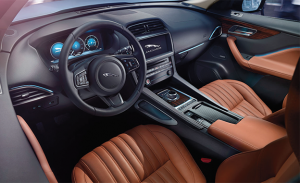
Probably of more relevance to buyers of vehicles at this price point, the diesel-powered F-Pace can travel almost 600 miles on the highway before it needs a refill.
There isn’t another high-end crossover in this class or the next up class that can touch that – especially now that Benz (GLE, GLS) and BMW (X series) have pulled their formerly available diesel engines from their U.S. model lineups.
And if hustle matters to you more than legs, the 2018 F-Pace can be ordered with two high-performance gas engines: There’s the standard turbocharged four – and a supercharged V6, the latter offered in two states of tune (340 or 380 hp).
The 2.0 liter turbocharged four is new; it replaces the supercharged gas V6 as the standard F-Pace engine.
The supercharged V6 – and turbodiesel four – remain available optionally.
Two new electronic driving aids have been added to the equipment roster as well: Forward Traffic Detection – a collision avoidance technology – and Forward Vehicle Guidance – a parking assist technology.
The Equalizer can go off-road now.
Diesel delivers near-hybrid fuel economy and range – without the complexity, cost or added weight of the hybrid layout (which always mucks up the handling)
Torque enough to get air under the front wheels . . . almost.
Has pulling power: The diesel-powered Jag’s max tow rating is 5,290 lbs. vs. 4,409 for the gas-engined Porsche.
Costs thousands less to start than the base Porsche Macan – even when equipped with its optionally available turbodiesel engine.
To pass muster with Uncle, the Jag’s diesel is equipped with urea injection – so you’ll have to top off periodically with Diesel Exhaust Fluid (DEF).
Also Because Uncle, diesel fuel has become the most expensive fuel – often it costs more per gallon than unleaded premium.
Rearward visibility is poor, sacrificed on the altar of good looks.
UNDER THE HOOD
One of the neat things about this jacked-up cat is the panoply of engine options. Instead of the usual two – and usually gas engine-only – you’ve got three choices.
And three different types of engines: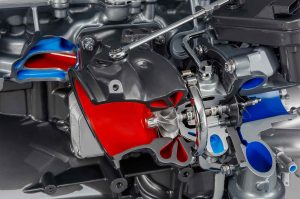
Turbocharged gas four, supercharged gas V6 . . . and turbodiesel four.
The turbo four is standard and F-Paces so equipped carry the 25t designation. This engine displaces 2.0 liters and makes 247 horsepower and 269 ft.-lbs. of torque at 1,200 RPM. It is very similar in layout and output to the Macan’s standard 2.0 liter turbo four, which makes 252 hp and 273 ft.-lbs. of torque at 1,600 RPM.
The Jag’s four is paired with an eight speed automatic; the Macan uses a seven speed automated manual. Both come standard with full-time all-wheel-drive systems that are rear-biased, meaning that until slippage is detected, almost all of the engine’s power goes to the rear rather than the front wheels.
This is the preferred layout for high-speed handling and is uncommon in crossover SUVs because most of them (including those made by Lexus and Acura) descend from mass-market, FWD passenger cars. The Lexus RX, for example, traces its lineage back to the Toyota Camry.
The Jag and the Porsche descend from more exclusive rear-drive sports cars.
Front-biased crossovers are usually good in the snow – because they have more weight over the primary drive wheels and because there is a snow-day advantage in pulling rather than pushing.
But their high-speed handling/cornering capabilities are compromised because they are nose heavy – and light in the tail. Also, because the primary drive wheels are also the wheels that steer the thing.
And it’s the reason why almost all serious race cars – and street high-performance cars – are either rear-wheel-drive or rear-drive biased AWD.
As here.
The F-Pace has a performance monitor that shows you the power split in real time; the transition from rear-drive to all-wheel-drive . . . as you drive. There are also multiple/selectable Drive modes, including Rain/Ice/Snow, Eco, Normal and Dynamic, which is the sportiest setting.
Like the Porsche, the Jag’s got also launch control – a system that uses the traction control and ABS along with throttle programming to give you the quickest and most controlled acceleration by automatically modulating power delivery to match the available traction. Tap the screen to engage, then floor the gas pedal and keep it floored. No need to back off when the wheels slip.
No fishtailing, no stumbling.
Just going.
Equipped with the 2.0 liter turbo four, the F-Pace gets to 60 in about 6.3 seconds. EPA says this version of the Jag is good for 22 MPG in city driving and 27 on the highway. These numbers are very competitive with the turbo four-powered Macan, which is slightly quicker – it gets to 60 in about 6.1 seconds – and also slightly thirstier – 20 city, 25 highway.
The next up F-Pace engine is a supercharged 3.0 liter V6.
It’s available in 340 and 380 hp versions and (as with the turbo four) it’s paired with the eight speed automatic and full-time AWD.
Equipped with this engine, the Jag’s zero to 60 run drops to about 5 flat.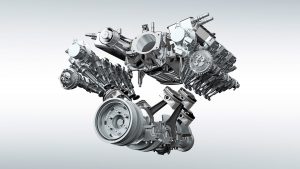
Mileage also drops, too – but less than you might expect given the horsepower and performance uptick.
EPA says 18 city, 23 highway.
Again, par vs. the Macan’s optional – and also 3.0 liter – but turbocharged rather than supercharged – V6. Which makes 340 or 360 hp depending on the version. It gets the Porsche to 60 in about the same five flat.
At this point, the two crossovers diverge like the course of two mighty rivers.
The Jag can be ordered – uniquely in this class – with a 2.0 liter turbodiesel four. It makes 180 hp and 318 ft.-lbs. of torque at 1,750 RPM. This engine emphasizes low-end grunt, pulling power and extremely long highway legs.
Keep it under 70 and it’ll go close to 600 miles on a full tank. During a weeklong test drive, I averaged almost 34 MPG better than the EPA’s highway projections. This is not unusual for diesel-powered vehicles, which routinely do better than the advertised city/highway estimates.
With gas-engined vehicles, it’s almost always the reverse.
The Macan offers nothing comparable. It goes in the other direction. You can buy it with a 440 hp 3.6 liter turbo six, the same basic engine that’s available in the 911.
It won’t go 400 miles on a tank.
But it will get to 60 in 4 seconds.
Diesels are the natural powerplant for a vehicle like the F-Pace. Which is about utility and sport, remember. Diesels pull like draft horses – and keep pulling without having to be “watered” every two hours or so.
As mentioned earlier, miles-per-gallon isn’t an economic issue for anyone with the means to buy a vehicle like the F-Pace or the Macan. If it were, they wouldn’t be shopping for Jaguars or Porsches to begin with.
But miles-in-between fill-ups, that’s something else. It’s luxurious to be able to trundle along for five or six hours at a stretch on the highway without having to pit.
The diesel is like having a personal executive bodyguard with you at all times. It’s quiet and in the background – but there, immediately, when you need it. At highway speeds, it’s barely idling – 1,600 or so RPM at 70 in top gear.
Unlike the gassers – which need to rev to make their horsepower – the diesel’s torque is always on tap.
Revving the Jag’s engine is as unnecessary as adding grease to bacon.
There is much torque on tap that – initially – there is a learning curve. You learn to push lightly on the accelerator pedal. Give it the usual half pedal when the light goes green and you may be startled by how the front end lifts, how assertively the Jag jumps forward.
But this is the good kind of getting-used-to.
It’s also nice to execute a pass without the usual high-RPM scream.
And if you do ever have to deal with heavy snow or mud or anything that is made better and easier via leverage, you will thank the motor gods for the low RPM grunt of the turbodiesel engine.
But it’s lonely up on top of the mountain. The F-Pace is the only vehicle of its type you can still get with a diesel powerplant. Bad news for Porsche, Benz and BMW.
Great news for Jag.
Provided, of course, Jag can continue offering it.
The other thing the Jag offers – in all F-Paces – is damping unlike any other. What is “damping”? It is the opposite of bouncing. When the F-Pace encounters a dip in the road, it doesn’t rebound. It absorbs the motion as fluidly as a cat leaping from a window two stories to the ground below.
You have to drive this thing – fast – to experience it and to believe it.
Crossovers are necessarily about compromises. They’ve become popular for exactly that reason, too.
Porsche developed the Cayenne (and then the Macan) because so many potential 911 and Cayman buyers needed more than a personal-sized car with a tiny trunk that was useless as a family car and hopeless as a snow-day car.
It was a bold – and profitable – decision.
Jaguar made the same decision, for the same reasons.
The trick – for both Jaguar and Porsche – was to build a crossover that doesn’t drive – or look – like a compromise.
It’s a job right up there with making your 47 year old wife look (and drive) like your 23-year-old girlfriend.
They succeeded enough.
Neither the Porsche nor the Jag will excite your senses to the degree that a two-door Porsche or Jag does. But they also don’t leave you indifferent and wondering: Why the hell didn’t I just buy a RAV4 or CR-V instead?
The Jag – like the Porsche – has some sexy lines yet.
Perhaps like your 47-year-old wife.
The subtle hood bulge, for one. And the more-than-usually low-cut side glass, which makes the F-Pace seem as though it’s sitting lower even though it’s not.
Viewed from head on, slightly off center, there’s enough Jaguar-ness to be convincing – and that’s all that matters, really.
Though nominally a compact crossover, the F-Pace is closer to being functionally mid-sized than the Macan. It is 186.3 inches long (vs. 184.3 for the Porsche) and has 43 inches of legroom up front vs. 41 inches for the Macan. Second row legroom is dead heat – 37 inches in the Jag vs. 37.4 in the Porsche – but the Porsche’s 911-esque up-canted roofline allows a bit more usable headroom.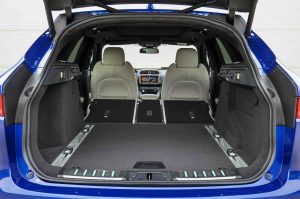
On the other hand, the Jag’s extra length allows significantly more total cargo capacity: 63.5 cubic feet (with the second row folded) vs. 53 cubic feet for the Macan.
And the F-Pace has a bit more ground clearance: 8.3 inches vs. 7.8 for the Porsche.
It would be interesting to see which of the two goes up a ski slope better.
THE REST
All trims come standard with a full-roof panorama roof, LuxTec leather trim, an 8-inch color LCD touchscreen and a very good 11-speaker Meridian audio system. A larger (10 inch) touchscreen is available as part of the optional Technology Package, which also includes a configurable LCD main gauge cluster, an even better 17 speaker ultra-premium Meridian sound system and in-car WiFi.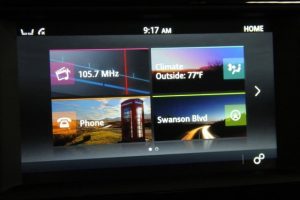
The Jag also offers some unique and not gimmicky features, such as a grid heater for the windshield (as in Land Rover SUVs) which helps de-ice and de-fog your forward view as well as the view to the rear.
There is also a FitBit-style waterproof Activity bracelet that you can take with you while adventuring – leaving the shouldn’t-get-it-wet ignition key locked safely inside the car.
Just a couple of minor nits to point out – and most of these are subjective, as in just my opinion:
Like other Jags, the F-Pace has a rotary knob gear selector that is flush with the console surface until the push-button ignition is activated. It then rises elegantly to meet your hand. The nit – if you’re a Speedy Gonzalez type like me – is that it does take a moment to rise up out of the console and until it does, you can’t select a gear and get going.
Old-school shift levers aren’t as elegant, but you can jam them from Park to Drive as soon as you jump in the driver’s seat.
On the other hand, the Jag’s rotary knob has some tactile feedback – which the toggle/tap shifters becoming popular in high-end vehicles haven’t got any of.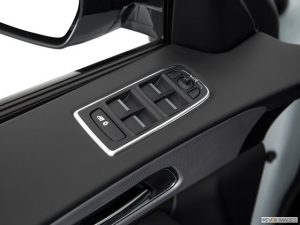
The power window controls are mounted on top of the door panels, rather than the usual somewhere lower down, near the door pulls. So you have to raise your hand up to activate the controls. It’s a little odd-feeling at first.
Those two are subjective – one man’s opinion.
The objective nit is the rear glass slit. Holy man falling down the well, Batman! It’s a small slice of glass, maybe two feet square – canted at what appears to be a 45 degree angle. About a fourth of this is hooded by the integrated roof airfoil, which extends outward over the glass, darkening what view there is.
Making the view even worse – and this part isn’t Jaguar’s fault – are the Uncle-mandated tall boy anti-whiplash headrests mounted atop the rear seats. These eat up probably a fourth of the already not-much peripheral vision.
But hey, it’s a Jag.
Form matters a bit more than function here.
THE BOTTOM LINE
It’s not as quick as the Macan, but it’ll go farther – and for less.
If you like what you’ve found here, please consider supporting EPautos.
We depend on you to keep the wheels turning!
Our donate button is here.
If you prefer not to use PayPal, our mailing address is:
EPautos
721 Hummingbird Lane SE
Copper Hill, VA 24079
PS: EPautos stickers are free to those who send in $20 or more to support the site. Also, the eBook – free! – is available. Click here. Just enter you email in the box on the top of the main page and we’ll send you a copy ASAP.




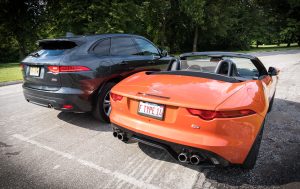
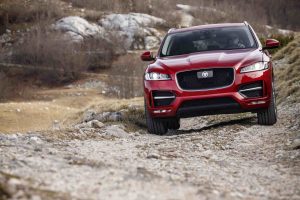
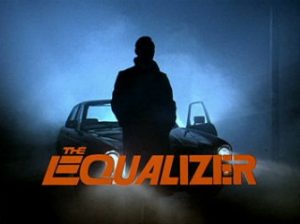
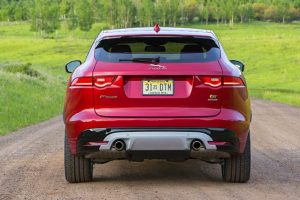
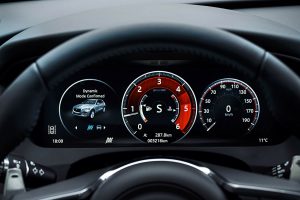
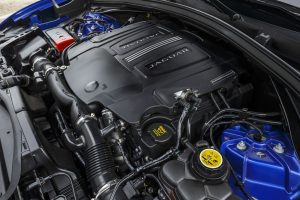

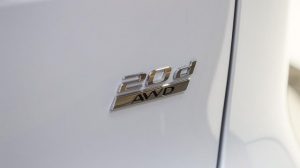
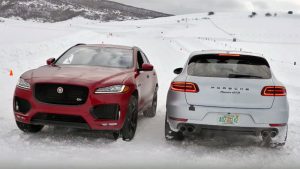








All I know is thus:
Last fall, 2016, we drove from the Pac NW to Lake Tahoe area and back gor an extended weekend vacation. 1306 total miles driven, average speed mph 63, average miles per gallon mpg 53.1.
That’s all I know, oh wait, I also know that the EPA would like my car in a crusher..
So I know two things about diesels.
Sarc!
And our lowly B7 TDI only has 238 ft pounds of torque. I’d sure like to experience the 4 S diesel V8 Porsche Panamera (in Sport Tourismo ‘wagen’ trim bitte) diesel at 610 ft pds of torque, btw.
A neighbor has one – I’ve really only seen the back of it, but the general impression is that it looks like any other curvy crossover being sold today. And that styling wise, it doesn’t stand out. Maybe he had a lower trim level.., but it looked like something from the Koreans.
Hi Chip,
It’s best viewed from the front, offset…
Unless you drive for a living or just love the torque, I don’t see the point of a modern diesel- the computers in the car will die long before the engine does and it won’t be worth it to fix it, if you can even find parts down the road. Probably true even of modern gas engines. Diesels are for running 20 or more years with normal use- and I don’t see this thing or any new car lasting that long without major expense/hassle
Hi Anchar,
That’s a valid concern, no question.
As to why… it’s nice to have all that low-down torque and the easygoing power delivery, plus the range… almost 600 miles on a tank, in this case.
Anchar, probably you’re right but diesels still have a spot in pickups even though I wouldn’t put their electronic life as better than cars but seems like that category has more aftermarket fixes, probably because only 3 companies make the heavy duty models.
I think many buy them not only for a high towing weight and better fuel mileage but their drivelines have to be stronger.
There was a time when a diesel pickup would sit and idle in the heat without overheating like many gasoline pickups did but it seems that’s not a factor any longer.
This may not be a big thing in many states but nobody wants to leave their pets in a hot pickup and leaving the windows down isn’t an option. I can honestly say the superior a/c cooling in a diesel pickup has kept many people also from succumbing to intolerable heat.
I had a good laugh one day when I pulled up on a location with a load and a diesel crewcab was sitting there running with 5 hands sound asleep. I laughed and pointed to the foreman in a pickup right behind me knowing the boss was only a minute or less away. That pickup emptied fast and nobody even knew where they were and didn’t have anything handy to look like they were doing except on enterprising guy who jumped on a backhoe and fired it up slamming the hoe back into a ditch that couldn’t be dug because of rock but he looked like he was working. I was hauling rock so I dumped it and went back for another load as the boss arrives. Sure wish I’d had a dashcam vid of it.
But seriously, I’ve been to places where the family was asleep in the truck waiting for something.
Anchar,
Having owned and driven (and, alas, lost in a wreck) a diesel VW Touareg, you’re points are correct, but they don’t show the whole picture of the appeal of a diesel for those “in the know.” In reality, diesels in most applications of heavy-duty pickups and below make no economic sense. With a few exceptions, gas engined heavy duty pickups can perform the job adequately for a lot less money, both in fuel and in routine maintenance. It’s tough to justify the extra cost of the vehicle itself when new as well as the extra cost of the fuel. That’s why fleet managers who know their stuff generally go with gas engined models. They know that there are pre-determined mileage or age sunsets for any vehicle they purchase, and as long as a gas engined version can meet the minimum requirements, they’ll be cheaper over the lifespan of the vehicle, even to 10+ years out and 200k miles or more. Usually diesels are bought more for machismo and because some politician in city hall wants them instead of gas. There are clear use case exceptions where there’s no substitute for a diesel, but bear in mind that most HD gas engined pickups today are rated to tow as much or more than the top diesel pickups of 15 years ago could, and the loads aren’t heavier, the trailers aren’t bigger, etc. in most cases.
That said, gas vs. diesel in passenger vehicles isn’t the same sort of argument. Whereas real-world mpg differences in HD pickups from gas to diesel average in the 1-2mpg range, in passenger cars it’s more like a 20-30% bump for the diesel. Diesel and premium gas vie for the most expensive fuels at most gas stations, but there are times of the year when diesel is cheaper than regular 87 octane gas in most of the US.
More importantly, SUVs are meant for travel, be it to and from work or across the highways and byways. Load up the luggage and cruise 600 miles between stops and the great American road trip gets that much greater. In the meantime, back in the daily grind, the low-end torque means off the line and around town driving is actually much sportier than the gas engined version, even if it DOES run out of breath north of 80mph compared to the gas model.
Nobody is going to buy a Jag for longevity. They’re built for comfort, a little sportiness, and for looking at. On the highway, diesel is far more luxurious than all but the most potent gas engines out there. It’s smooth, quiet, and pulls like a freight train without a lot of racket or drama. Throw a trailer behind it (for camping or for the utility side of the equation) and you’ll be much happier with the diesel than with a gas engine. Just because a gas engine CAN pull it, doesn’t mean it pulls as well or as comfortably and easily as the diesel.
Diesels make a lot of sense in SUVs, where you’re not looking for sports-car performance but instead value fuel efficiency, comfort, and utility more. In that regard, diesel SUVs are immensely capable, even if modern Jags won’t last 10 years before the electronics (and everything else) go kaput.
Get ’em while you can.
Following Germany and the UK’s lead.
China plans to ban cars that run on gasoline or diesel
http://www.latimes.com/business/autos/la-fi-hy-china-vehicles-20170911-story.html
Hi AF,
I have a Benz GLC this week – in the same class as the Jag and Benz had promised a BlueTec diesel option- but that’s off the table now.
As a Jaguar traditionalist, with the exception of the F-type, I haven’t liked anything Jaguar has put out in a while. The XJ looks like a alligator mated with an anteater. The XF looks like a Lexus something or other. Not to fault Lexus. Toyota makes a great and reliable luxoboat. It’s just something that Jaguar shouldn’t be doing. Their styling department has been out to lunch.
Although this thing has a lot of hideous design cues from its current lineup, it seems to work in this car. If I had $50k burning a hole in my pocket and was in the market for an SUV Crossover, I would give this one a serious look. The packaging is great, the layout is awesome, it has plenty of room, the diesel makes the car decent to drive. I would have to consider one.
I guess most buyers will have to wait until it depreciates to about $20k. Then, it’s worth a look. Until then, I will stay with my 2005 Acura MDX that I bought for $3800 and hope for the best. It likes to burn the premium, but $46k plus tax will buy me a lot of tankfuls at any price.
Hi Swamp,
How much better would this thing be with a diesel six?
Say about 450 ft.-lbs. of torque, on tap at 1,200 or so RPM… yeah, that’d be the ticket! That said, I’m still impressed – especially by the fact that it averaged about 34 MPG the whole time I had it.
These lease OK (since the residual is highest for diesel) if you don;t want to get stuck with dropping $50k on buying one.
Hi Bill,
Yup. I always advise waiting a year (or three) and buying the thing after someone else has eaten the 30-plus percent depreciation off sticker!
I used to wait for the new to wear off vehicles friends had and if they liked them I’d consider buying them. I even bought one a friend hated for a good reason but the fix was easy and the dealer so incompetent they were out of bidness before he bought a replacement. When a diesel cranks over fine and delivers fuel why won’t it start? Hint, and something I told him, it has an air leak. It can be a line but it’s often just a filter housing or fitting that doesn’t leak diesel, just air. I proved it to him once by replacing the fuel filters I primed before installation. It fired up instantly. So what do I do he asked. Get your propane torch(not lit) and run it along every part of the fuel system and when it speeds up it’ll be close or use starting fluid. He never did. I got the pickup for about 1/3 price.
I don’t know what the difference besides the name is now but I used to buy cans of “ether” and some diesel equipment had a place to mount one and the switch was labelled “ether”. Now it’s always starting fluid. There probably is a small difference but it’s rattle city when it fires just like “ether”. And now nothing has a place for that can or the switch to activate it. Starting fluid voids the warranty on everything now. That doesn’t mean everyone doesn’t use it, they just won’t admit it.
I use most of mine to blow the tire back on the bead. I even used it on a rear lawn mower tire, the only way I could get it to seat on the bead.
Yes, I remember when Jaguar stood for beauty. Beauty, of course, never goes out of style. Planned obsolescence prevents consistently beautiful designs.
As a kid, I knew a guy whose Dad owned an E-Type. It was car porn. We’d go into the garage where he kept it and just stare…
I saw a red E-Type roadster passing by the other day. I didn’t get the usual weird feeling I get when I see something so glorious. Instead, I felt a bit depressed. The notion that we’ll never see gorgeous cars like that being produced again is saddening. I used to be somewhat optimistic about the industry, but these past 10 years have been the most destructive. I’ll be shocked if things turn around.
Same here. I consider myself pretty knowledgable, but I don’t know which implementing legislation affected car design as it is now and even when it actually began. I know FMVSS 208 had a lot to do with side impact and crash standards. The automakers had until 2012 or 13 to have their cars completely redesigned. Some began a lot earlier as they were beginning their design cycles. I suspect it was towards the end of the Bush administration. I know for sure that Fuel Economy regs were enabled by teh Energy policy act of 2007. They had until 2016 to reach the 35.5 mpg figure. This regulation is costing us a fortune. As for safety regulations, I don’t know when congress mandated all of this. It is very unclear. The past 10 years have been horrible. I won’t buy a car made after 2007.
The details of witch doctery and how atilla EPA Compliance THugs will enforce the Marxist spells and incantations is in no way “knowledge.”
To produce value and to accrue wealth may require intimate familiarity with fatwas and holy environmental commandments, but mastery of such nihilist scriptures does not make one knowledgeable.
And I recall when Ford bought Jag. We all waited with baited breath. Rumors abounded. Ford kept the Jag styling dept. Ford put everybody in Jag on the unemployment line. Then we finally see a new Jag sedan, a slightly swoopier Crown Vic. Then more of the same next year. It was an ugly sight watching Jag turn into a Ford…….like watching Bentley turn into a Caprice……aaarrrggghhhh
A friend bought a new SJ6 in ’86 and it was a nice car, not a reliable car but looked good and drove good and was luxurious. Well, TaTa…..
I was hoping Jaguar’s poor reliability would be properly addressed under Ford’s watch.
As for styling, you can’t expect anything beautiful and elegant when you have a guy like Ian Callum in charge of the styling department. He’s been destroying Jaguar design for close to 20 years now.
Hi Handler,
In Jag’s (and Callum’s) defense, the market has changed. Classic Jaguars – especially sedans – were the apotheosis of elegance and style at a time when those qualities were esteemed by luxury car buyers. Today, “luxury” seems to equate with over-the-topness, with aggressiveness (note the emphasis on luxury-sport sedans) and, of course, technology.
This trend began decades ago when BMW began to shift away from catering to people who appreciated superb driving machines to status machines.
I, too, weep for the future – and mourn the past.
I think the luxury sport sedan craze has died down a bit. It’s especially no longer working for challenger brands like it did 20 years ago. Cadillac is a good example. The once successful CTS and compact ATS aren’t setting showrooms on fire like they had predicted. Meanwhile, the quintessential Cadillac, the Escalade, still sells like hotcakes. If only they had an opulent, sexy V8-powered Eldorado to sell. Cadillac would be back. Unfortunately, Cadillac execs are still adamant about turning it into a counterfeit German brand with a dash of cultural Marxism to appeal to young urban professionals.
It always ends badly when car companies get too obsessed with trends. The most sensible thing to do is keep doing what the brand/company does best while keeping it fresh. Individualism.
The technocracy train is coming fast with no signs of stopping. I’m worried….
Hi Handler,
I agree, it has. The crossover luxury-sport thing has taken its place! AWD and ground clearance is the new Brawndo; it’s what people crave.